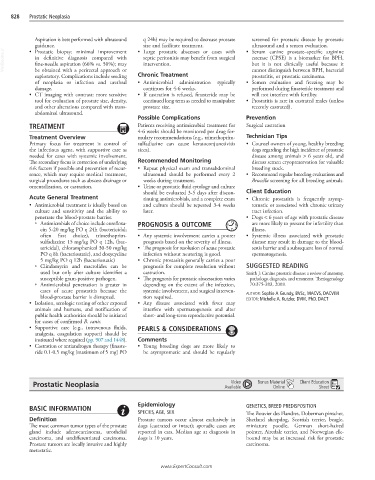Page 1643 - Cote clinical veterinary advisor dogs and cats 4th
P. 1643
828 Prostatic Neoplasia
Aspiration is best performed with ultrasound q 24h) may be required to decrease prostate screened for prostatic disease by prostatic
ultrasound and a semen evaluation.
size and facilitate treatment.
guidance. • Large prostatic abscesses or cases with • Serum canine prostate–specific arginine
VetBooks.ir in definitive diagnosis compared with septic peritonitis may benefit from surgical esterase (CPSE) is a biomarker for BPH,
• Prostatic biopsy: minimal improvement
but it is not clinically useful because it
fine-needle aspiration (66% vs. 50%); may
intervention.
be obtained with a perirectal approach or
exploratory. Complications include seeding Chronic Treatment cannot distinguish between BPH, bacterial
prostatitis, or prostatic carcinoma.
of neoplasia or infection and urethral • Antimicrobial administration typically • Semen evaluation and freezing may be
damage. continues for 4-6 weeks. performed during finasteride treatment and
• CT imaging with contrast: more sensitive • If castration is refused, finasteride may be will not interfere with fertility.
tool for evaluation of prostate size, density, continued long term as needed to manipulate • Prostatitis is rare in castrated males (unless
and other alterations compared with trans- prostate size. recently castrated).
abdominal ultrasound.
Possible Complications Prevention
TREATMENT Patients receiving antimicrobial treatment for Surgical castration
4-6 weeks should be monitored per drug for-
Treatment Overview mulary recommendations (e.g., trimethoprim- Technician Tips
Primary focus for treatment is control of sulfadiazine can cause keratoconjunctivitis • Counsel owners of young, healthy breeding
the infectious agent, with supportive care as sicca). dogs regarding the high incidence of prostatic
needed for cases with systemic involvement. disease among animals > 6 years old, and
The secondary focus is correction of underlying Recommended Monitoring discuss semen cryopreservation for valuable
risk factors if possible and prevention of recur- • Repeat physical exam and transabdominal breeding stock.
rence, which may require medical treatment, ultrasound should be performed every 2 • Recommend regular breeding evaluations and
surgical procedures such as abscess drainage or weeks during treatment. Brucella screening for all breeding animals.
omentalization, or castration. • Urine or prostatic fluid cytology and culture
should be evaluated 3-5 days after discon- Client Education
Acute General Treatment tinuing antimicrobials, and a complete exam • Chronic prostatitis is frequently asymp-
• Antimicrobial treatment is ideally based on and culture should be repeated 3-4 weeks tomatic or associated with chronic urinary
culture and sensitivity and the ability to later. tract infection.
penetrate the blood-prostate barrier. • Dogs < 6 years of age with prostatic disease
○ Antimicrobials of choice include enrofloxa- PROGNOSIS & OUTCOME are more likely to present for infertility than
cin 5-20 mg/kg PO q 24h (bactericidal; illness.
often first choice), trimethoprim- • Any systemic involvement carries a poorer • Systemic illness associated with prostatic
sulfadiazine 15 mg/kg PO q 12h, (bac- prognosis based on the severity of illness. disease may result in damage to the blood-
tericidal), chloramphenicol 30-50 mg/kg • The prognosis for resolution of acute prostatic testis barrier and a subsequent loss of normal
PO q 8h (bacteriostatic), and doxycycline infection without neutering is good. spermatogenesis.
5 mg/kg PO q 12h (bacteriostatic) • Chronic prostatitis generally carries a poor
○ Clindamycin and macrolides can be prognosis for complete resolution without SUGGESTED READING
used but only after culture identifies a castration. Smith J: Canine prostatic disease: a review of anatomy,
susceptible gram-positive pathogen. • The prognosis for prostatic abscessation varies pathology, diagnosis, and treatment. Theriogenology
○ Antimicrobial penetration is greater in depending on the extent of the infection, 70:375-383, 2008.
cases of acute prostatitis because the systemic involvement, and surgical interven- AUTHOR: Sophie A Grundy, BVSc, MACVS, DACVIM
blood-prostate barrier is disrupted. tion required. EDITOR: Michelle A. Kutzler, DVM, PhD, DACT
• Isolation, serologic testing of other exposed • Any disease associated with fever may
animals and humans, and notification of interfere with spermatogenesis and alter
public health authorities should be initiated short- and long-term reproductive potential.
for cases of confirmed B. canis.
• Supportive care (e.g., intravenous fluids, PEARLS & CONSIDERATIONS
analgesia, coagulation support) should be
instituted where required (pp. 907 and 1448). Comments
• Castration or antiandrogen therapy (finaste- • Young breeding dogs are more likely to
ride 0.1-0.5 mg/kg [maximum of 5 mg] PO be asymptomatic and should be regularly
Video
Prostatic Neoplasia Available Bonus Material Client Education
Sheet
Online
Epidemiology GENETICS, BREED PREDISPOSITION
BASIC INFORMATION
SPECIES, AGE, SEX The Bouvier des Flandres, Doberman pinscher,
Definition Prostate tumors occur almost exclusively in Shetland sheepdog, Scottish terrier, beagle,
The most common tumor types of the prostate dogs (castrated or intact); sporadic cases are miniature poodle, German short-haired
gland include adenocarcinoma, urothelial reported in cats. Median age at diagnosis in pointer, Airedale terrier, and Norwegian elk-
carcinoma, and undifferentiated carcinoma. dogs is 10 years. hound may be at increased risk for prostatic
Prostate tumors are locally invasive and highly carcinoma.
metastatic.
www.ExpertConsult.com

